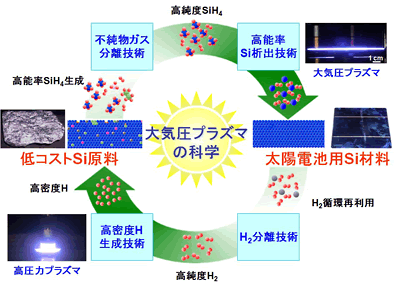
HOME >> Principle Investigators,Research Themes
- Hiroshi Irie
- Efficient Visible Light-Sensitive Photocatalysts for Water Splitting
- Hiroaki Okamoto
- Hydrogenated amorphous silicon free from light-indueced degradation
- Shinichi Satoh
- Complete utilization of "light"and "carrier" by the control of interface between surface layer and photovoltaic materials.
- Liyuan Han
- Device Physics of Dye-sensitized Solar Cells
- Masahiro Hiramoto
- Bandgap Science for Organic Solar Cells
- Yoshiji Horikoshi
- High efficiency thin film solar cells with enhanced optical absorption by excitons
- Kiyoshi Yasutake
- New Formation Process of Solar-Grade Si Material Based on Atmospheric-Pressure Plasma Science
Outline
This study will contribute to creative technology for obtaining clean and renewable energy through hydrogen evolution using a water-splitting photocatalyst upon irradiation with visible portion of solar light. The photocatalysts will be created on the basis of a novel material design and mechanistic approach, and not a mere extension of previous studies. In addition, to enhance the ability of hydrogen evolution, the nano-scale structure of the photocatalysts will be strictly controlled to achieve effi cient charge separation, i.e., spatial separation of the redox reaction sites and optimization of the hetero-junctions.
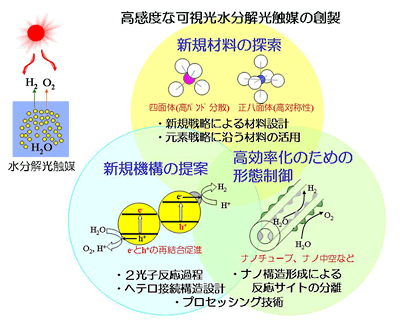
Hydrogenated amorphous silicon free from light-indueced degradation
Hiroaki Okamoto
Professor, Osaka University
![]() http://www.semi.ee.es.osaka-u.ac.jp/okamotolab/jp/index.html
http://www.semi.ee.es.osaka-u.ac.jp/okamotolab/jp/index.html
Outline
This program is aimed to pursuing novel growth and posttreatment technologies that make hydrogenated amorphous silicon be free from light-induced degradation. The scientifi c knowledge and technologies established would contribute largely not only to the evolution of practical thin-fi lm photovoltaics but also to the reformative progress in the science & technology of thin-fi lm silicon materials and related devices.
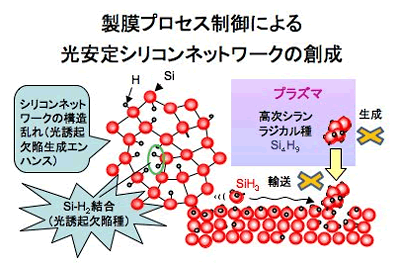
Outline
It is necessary to utilize incident "light" and generated "carrier" completely for the ultimate benefit of the photovoltaic potential. In this study, we establish a novel physical model for the losses of light and carriers at the interface between surface layer and photovoltaic materials. We also explore novel materials for the surface layer by using combinatorial technique. Our aim is to promote a high convergent efficiency photovoltaic based on the novel physical model and materials.
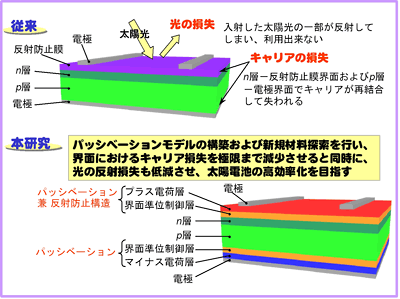
Outline
There has been an increasing interest in dye-sensitized solar cells DSCs owing to a potential for low-cost production. However, the energy conversion efficiency is still lower than that of bulk silicon solar cells. In this study, we try to find out the new methods for elevating efficiency to 15% by clarifying the performance principle of dye-sensitized solar cells and the properties of constituent materials (dye, metal oxide semiconductor and electrolyte) through collaboration with different research fields such as electrochemistry, organic chemistry, semiconductor physics, surface science and computational science.
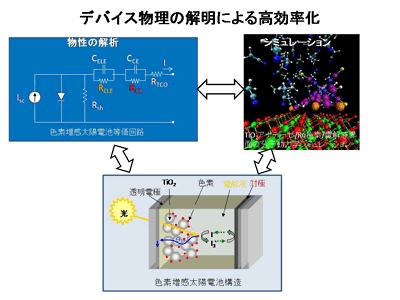
Bandgap Science for Organic Solar Cells
Masahiro Hiramoto
Professor, National Institutes of Natural Sciences, Institute for Molecular Science
![]() http://www.ims.ac.jp/english/know_en/materials/hiramoto/hiramoto_en.html
http://www.ims.ac.jp/english/know_en/materials/hiramoto/hiramoto_en.html
Outline
Target of this research project is the realization of organic solar cells showing conversion efficiency of 15%. In order to accomplish this target, we establish the bandgap science for organic semiconductors, such as eleven nines (11N) high purification, pn-control by doping, built-in potential formation, ohmic junction formation, precise evaluation of semiconductor parameters, together with the science of excitons and organic/inorganic heterointerfaces.
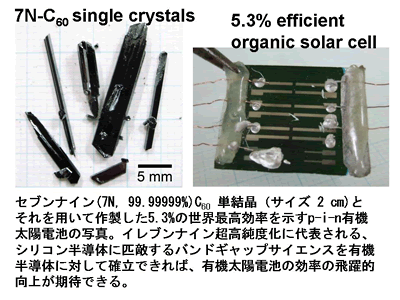
Outline
Thin fi lm structures are essential for achieving low cost solar cells. However, thinning the active regions of solar cells often reduces the optical absorption effi ciency. Enhancement of optical absorption in thin fi lms is therefore required to keep the bulk effi ciency and also to improve the total effi ciency of solar cells. In this project, we pursue the ways to enhance optical absorption in thin fi lms and to develop high effi ciency solar cells. Exciton absorption is one of the promising candidates, because it can be added to the normal band-to-band
absorption. Semiconductors with high exciton binding energy such as ZnO, GaN and CdAlSe2 are important materials in the shorter wavelength regions. The semiconductors sensitive to the main part of the solar spectrum exhibit rather lower binding energies, but by constructing superlattice and/or quantum dot structures, the exciton absorption can be considerably enhanced even in these materials. These investigations
are based on the high quality thin fi lms and heterostructures with wide areas grown by MBE, MEE and magnetron sputtering.
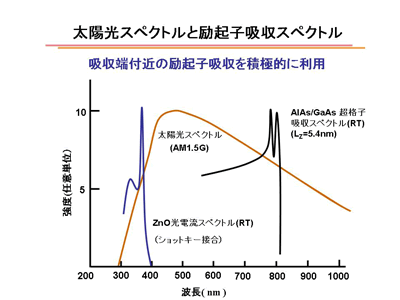
Outline
In this research, a new manufacturing process of solar-grade Si directly from low-cost, low-purity Si materials is developed using high-pressure H2 plasma generated at near atmospheric pressure. By clarifying fundamental phenomena occurring in the high-pressure plasma and on the Si surface at an atomic level, we establish a technique to control plasma and surface reactions, and enhance the silane generation reaction from low-purity Si materials. It is expected that this process significantly contributes to the solution against the shortage problem of solar-grade Si, and to the large reduction of the manufacturing cost of solar cells.
